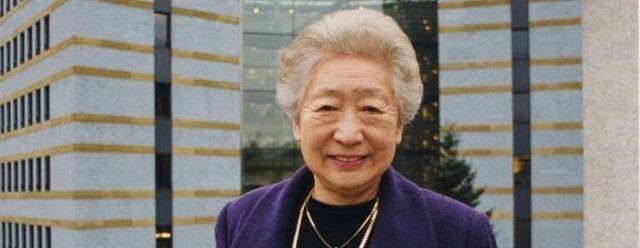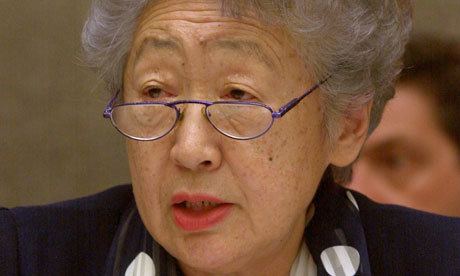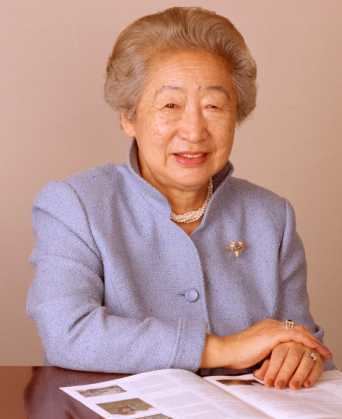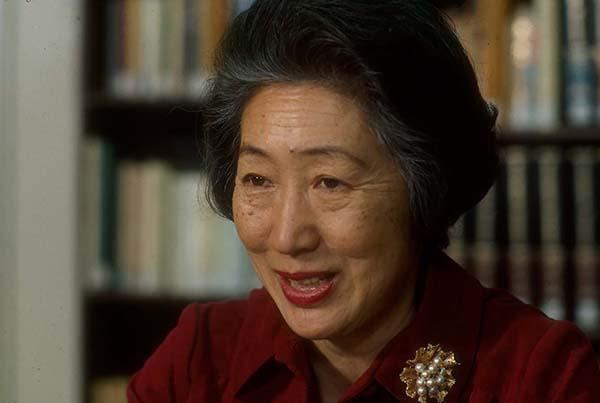Spouse Shijuro Ogata (m. ?–2014) Religion Roman Catholicism | Name Sadako Ogata Children Atsushi Ogata Role Diplomat | |
 | ||
Full Name 中村 貞子 (Nakamura Sadako) Alma mater University of the Sacred HeartGeorgetown University Books The Turbulent Decade: Confronting the Refugee Crises of the 1990s Awards Indira Gandhi Prize, J. William Fulbright Prize for International Understanding | ||
the idea of service sadako ogata looks back
Sadako Ogata, née Nakamura (緒方 貞子, Ogata Sadako, born 16 September 1927) is a Japanese academic, diplomat, author, administrator, and professor emeritus at Sophia University. She is widely known as the United Nations High Commissioner for Refugees (UNHCR) from 1991 to 2000, as well as in her capacities as the Chairman of the UNICEF Executive Board and as the President of the Japan International Cooperation Agency (JICA). She was a lecturer of the International Christian University (ICU), and is now the advisor of the Executive Committee of the Model United Nations (present day Japan Model United Nations, JMUN) as the founder of the Model United Nations in Japan.
Contents
- the idea of service sadako ogata looks back
- Press conference highlights from icpd cairo including unhcr sadako ogata 1994
- Early and academic life
- Family
- Career
- Japanese decorations
- Other
- Quotes
- References

Press conference highlights from icpd cairo including unhcr sadako ogata 1994
Early and academic life

Ogata was born on 16 September 1927 to a career diplomat father Toyoichi Nakamura, who was the Japanese ambassador to Finland. Her mother was the daughter of Foreign Minister Kenkichi Yoshizawa and granddaughter of Prime Minister Inukai Tsuyoshi, who was assassinated when Sadako was four years old.

She attended the Catlin Gabel School, class of 1946, and graduated from the University of the Sacred Heart (a Catholic university in Tokyo) with a bachelor's degree in English Literature. After that, she studied abroad at Georgetown University and its Edmund A. Walsh School of Foreign Service in the US for a master's degree in International Relations. It was not common for a Japanese woman to study abroad at that time in Japan, even though the democratic days came after the end of WWII in Asia following the surrender of Japan. She wanted to study the causes of Japan's defeat in war at a university in the US. She was awarded a PhD in Political Science from the University of California, Berkeley in 1963, after she completed a research report on the policy formation of the foundation of Manchukuo by Japan in 1931. The report provided some clues to the causes of the Japanese invasion in China, which led to the defeat. In 1965, she became a lecturer at International Christian University. After 1980, she taught international politics at Sophia University as a professor and later became the Dean of the Faculty of Foreign Studies until she left to join the UNHCR in 1991.
Family

In 1960, Nakamura married Shijuro Ogata (1927–2014), a son of Taketora Ogata who was also an official of the Bank of Japan and later became its Executive Director. After the marriage, her name changed to Sadako Ogata. She has one son (Atsushi Ogata, a movie creator) and one daughter.
Career

Ogata was appointed to a position as a Japanese member of the UN mission in 1968, on the recommendation of Fusae Ichikawa, a member of the House of Councillors of Japan and a famous woman activist who thought highly of Ogata. After that, she represented Japan at several sessions of the UN General Assembly in 1970. In addition, she served from 1978–79 as envoy extraordinary and minister plenipotentiary at the permanent mission of Japan to the UN, and as the Chairman of the UNICEF Executive Board.
In 1990, she was nominated and appointed as the United Nations High Commissioner for Refugees (UNHCR). She left the position of professor (political science) at Sophia University in Tokyo, quickly moved to Geneva, and started her new position at the UNHCR. The presumed term at UNHCR was only about three years, namely, the remaining days of the abruptly left predecessor's term. After arrival at the post in 1991, however, her leadership and active works led to her staying from 1991 until 2001.
After 2001, she was appointed as the co-chairperson of UN Human Security Commission and she engaged in the reminiscences of her works for the refugees at home in New York. After the September 11 attacks, in 2002, she was chosen as Special Representative of the Prime Minister of Japan on Reconstruction Assistance to Afghanistan in order to support the reconstruction of Afghanistan. Next year, going back to Tokyo, the Japanese Government appointed her as the president of the Japan International Cooperation Agency (JICA) on 1 October 2003. Though she was over 70 years old, she was appointed as the post due to her abilities and her leadership. It was reported that young JICA officials expressed their strong hope for her inauguration, even before the formal appointment. She continued to work as the president of JICA for more than two terms (over eight years), retiring in April 2012 to be succeeded by Akihiko Tanaka.
She was a member of The Advisory Council on the Imperial House Law which was settled as Junichiro Koizumi the Prime Minister's private advisory organ which belonged to the Cabinet Office on November 27, 2014. The conferences of the council were held in 17 times from January 25, 2005 to discuss the Japanese succession controversy and the Imperial Household Act. On 24 November 2005, The Advisory Council submitted the report including the approval of not only female imperial ruler but also female lineage imperial ruler, and the primogeniture with priority for succession of the Emperor. Her alma mater is the same as the Empress Michiko's, the University of the Sacred Heart.
A "Reception for Respecting Mrs. Sadako Ogata's Contributions to Our Country and the International Community" was held by Kōichirō Genba, Minister for Foreign Affairs on April 17, 2012, in Tokyo. Prime Minister Yoshihiko Noda gave the greeting to her. He said that "Because of the 2011 Tōhoku earthquake and tsunami, the offers of assistance to Japan from more than 160 countries and more than 40 international organizations were NOT irrelevant to Mrs. Sadako Ogata's achievements". Ogata is an Eminent Person of the Sergio Vieira de Mello Foundation.
